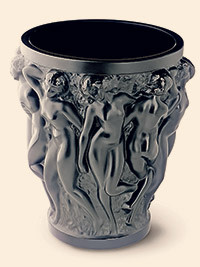Design Classic: the Bacchantes vase by René Lalique

Simply sign up to the Life & Arts myFT Digest -- delivered directly to your inbox.
René Lalique (1860-1945) was one of the most famous glass designers of the 20th century, creating perfume bottles for houses including Coty, Roger & Gallet and Worth. His design for Nina Ricci’s L’Air du Temps led to it being named Bottle of the Century at the Fragrance Foundation Awards in 1999. Lalique’s signature style was influenced by the Art Nouveau movement, with its nymphs, flora and fauna, and celebration of the female form.
One of his most famous pieces is the Bacchantes vase, first created on July 22 1927 and continuously in production ever since. It is one of the best-selling Lalique products ever made, with its depiction of neoclassical nudes (actually the young priestesses of Bacchus).
Made by hand, it was originally created in opalescent, amber or smoked glass, and in 1947 a satin finish was added. A limited-edition black crystal version was produced in 2004. For its 80th anniversary in 2007, it was made in amber with each piece having its own unique shade.
Lalique was born in Ay, a village in France’s Champagne region. He started as a jewellery designer making pieces for Cartier and Boucheron, but then experimented with glass.
By 1909 he had opened a glassworks outside Paris and abandoned jewellery design. In 1921, Lalique launched a second factory in Alsace as his work was in such demand.
He exhibited at the Paris Exhibition of 1925, showing off everything from tableware to statuettes and perfume bottles.
The Bacchantes vase followed two years later and Lalique continued to exhibit widely. A new shop followed in Rue Royale, Paris, but in 1939 his Alsace factory was occupied by the Germans. Lalique died aged 85 before it could reopen and the company was taken over by his son, Mark.
In 2008, the company was bought by Lalique collector Silvio Denz, who has since arranged collaborations with the Iraqi-born architect Zaha Hadid among others.
Comments